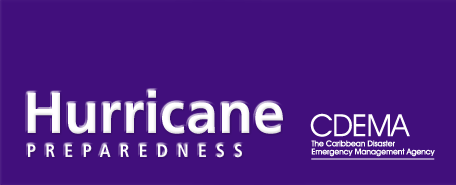|
|
Glossary
There are 83 entries in this glossary.| Term | Definition |
|---|---|
| Easterly Wave |
An inverted, migratory wave-like disturbance or trough in the tropical region that moves from east to west, generally creating only a shift in winds and rain. The low-level convergence and associated convective weather occur on the eastern side of the wave axis. Normally, it moves slower than the atmospheric current in which it is embedded and is considered a weak trough of low pressure. It is often associated with possible tropical cyclone development and is also known as a tropical wave. |
| El Niño |
A warming of the Pacific Ocean currents along the coasts of Peru and Ecuador near the Equator that is generally associated with dramatic changes or a shift in the weather patterns of the region. A major El Niño event generally occurs every 3 to 7 years and is associated with changes in the weather patterns worldwide including hurricane. |
| Emergency Operations Center |
A government emergency facility that serves as a central location for the coordination and control of all emergency preparedness and response disaster activities. Aliases (separate with |): EOC
|
| Emergency Public Shelter |
Generally a public school or other such structure designated by county or city officials as a place of refuge. A volunteer group such as the American Red Cross or Salvation Army usually manages a shelter. |
| Extratropical |
A term used in advisories and tropical summaries to indicate that a cyclone has lost its "tropical" characteristics. The term implies both poleward displacement of the cyclone and the conversion of the cyclone's primary energy source from the release of latent heat of condensation to baroclinic (the temperature contrast between warm and cold air masses) processes. It is important to note that cyclones can become extratropical and still retain winds of hurricane or tropical storm force. |
| Extratropical Cyclone |
A cyclone in the middle and high latitudes often being 2000 kilometers in diameter and usually containing a cold front that extends toward the equator for hundreds of kilometers. These cyclones form outside the tropics, the center of storm is colder than the surrounding air, have fronts and the strongest winds are in the upper atmosphere. |
| Eye |
The center of a tropical storm or hurricane characterized by a roughly circular area of light winds and rain-free skies and the lowest pressure. An eye will usually develop when the maximum sustained wind speeds exceed 78 mph. It can range in size from as small as 5 miles to up to 60 miles (20-50 km) but the average size is 20 miles. In general, when the eye begins to shrink in size, the storm is intensifying. |
| Eye Wall |
An organized band of convection surrounding the eye, or center, of a tropical cyclone. It contains cumulonimbus clouds, severest thunderstorms, heaviest recipitation and strongest winds. |
| Feeder Bands |
In tropical parlance, the lines or bands of thunderstorms that spiral into and around the center of a tropical system. Also known as outer convective bands, a typical hurricane may have three or more of these bands. They occur in advance of the main rain shield and are usually 40 to 80 miles apart. In thunderstorm development, they are the lines or bands of low-level clouds that move or feed into the updraft region of a thunderstorm. |
| Flood Plain |
Any land area susceptible to being inundated by water from any source. Normally the regulatory flood plain is characterized by the 100-year meaning there is a 1% chance of flooding per year. The flood plain is often referred to as flood prone areas. |
| Flood Warning |
The expected severity of flooding (minor, moderate or major) as well as where and when the flooding will begin. |
| Flooding |
A general and temporary condition of partial or complete inundation of normally dry land areas from the overflow of inland or tidal water or rapid accumulation or runoff of surface waters from any source. |
| Forecast |
A statement of expected future occurrences. Weather forecasting includes the use of objective models based on certain atmospheric parameters, along with the skill and experience of a meteorologist. Also called a prediction. |
| Forward Speed |
The rate of movement (propagation) of the hurricane eye in miles per hour or knots |
| Fujiwhara Effect |
A binary interaction where tropical cyclones within a certain distance (300-750 nautical miles depending on the sizes of the cyclones) of each other begin to rotate about a common midpoint. |


























